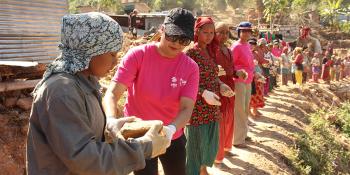
One year has passed since a devastating magnitude-7.8 earthquake struck Nepal on 25 April 2015, with the epicenter about 80 kilometers northwest of the capital, Kathmandu. This was the worst disaster to hit Nepal in decades. Only 17 days later a second earthquake of magnitude 7.4 hit near Mount Everest, taking more lives and destroying more homes. According to government estimates, the earthquakes left over 750,000 houses and buildings destroyed or damaged and caused over 8,790 deaths. It is estimated that the earthquakes affected the lives of approximately eight million people, constituting almost one-third of the population of Nepal.
With the situation dire, the Nepal government declared a state of emergency, and appealed for international aid. Along with other agencies, Habitat for Humanity answered the call to assist the people of Nepal. During the emergency phase, Habitat distributed 5,142 temporary shelter kits to families whose homes were destroyed or left uninhabitable. Habitat volunteers removed 650 tons of earthquake rubble, and distributed 20,000 water backpacks to families in earthquake-affected areas.
As the emergency phase ended, Habitat’s programs shifted into reconstruction. Engineers completed safety assessments on 16,244 earthquake damaged homes. Initial construction began on permanent homes in Kavre district. As months passed, winter brought the threat of cold weather exposure, and Habitat distributed 2,424 winterization kits to families at risk to the elements. In addition, 32 trainers and 632 people in affected communities received instruction on the Participatory Approach for Safe Shelter Awareness.
Overall in the first year since the earthquakes, Habitat for Humanity provided assistance to more than 43,700 families through various disaster response programs.
As the construction on houses began, the security and economic situation in Nepal took a difficult turn. Civil unrest and blockades created access problems, closing off supplies of fuel and building materials. As a result, construction on permanent housing and other programs was delayed, and then had to be suspended for several months. Gradually the demonstrations and blockades began to subside in February of 2016. Businesses reopened, transport resumed, and supplies of fuel and construction materials were once again brought into the country. As the situation stabilized, all of Habitat’s programs resumed. With these improvements, Habitat’s Global Village volunteers have since returned to Nepal, and housing construction has been restarted.
Looking ahead, Habitat anticipates the completion of construction on 87 houses by March 2017, and has finalized the organization’s new “Build Nepal” strategy. The vital sectors Habitat plans to support include: Social Mobilization (empowering communities to join and rebuild), Technical Assistance (training to provide improved construction skills for safer reconstruction), Tiered Assistance (providing vulnerable households nonfinancial support for income-generating activities so that they can build their own capacity) and Market Development (improving housing value through access to better construction materials and labor). These four pillars will uphold an overarching participatory approach, and put households and communities in charge of rebuilding their own homes.
The overall “Build Nepal” strategy aims for a long-term, post-earthquake recovery program of five years. Habitat for Humanity hopes to directly support more than 10,000 severely affected families in 15 communities or Village Development Committees with an estimated project implementation cost of US 15 million. However, our current secured funding of US 3.375 million allows only for a two-year project covering approximately 4,000 families in five communities in Kavre and Nuwakot. Habitat is seeking financial support to make the full scope of “Build Nepal” a reality.